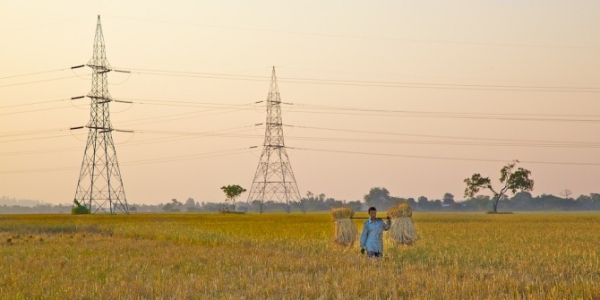 It is often assumed that electrification of rural households reduces the domestic workload for women, enabling them to engage in market based work, but new research looking at the long term impacts of rural electrification in India suggests the reality is more nuanced. Dominique Van De Walle writes that there is no doubt that better light, better air movement and entertainment bring welfare benefits. However, electrification seems to increase men’s labour supply more and may also come with increased demands on women’s time.
It is often assumed that electrification of rural households reduces the domestic workload for women, enabling them to engage in market based work, but new research looking at the long term impacts of rural electrification in India suggests the reality is more nuanced. Dominique Van De Walle writes that there is no doubt that better light, better air movement and entertainment bring welfare benefits. However, electrification seems to increase men’s labour supply more and may also come with increased demands on women’s time.
It is estimated that 1.3 billion people in the world in 2009 were still without electricity. Many rural households in the developing world continue to cook with wood and biomass (mainly dung), and spend a lot of time collecting and preparing fuel for domestic use. Across the world, these time (and resulting health) burdens are thought to be higher for women and the children under their care.
One popular argument is that by relieving time burdens spent in collecting and preparing fuel, household electricity results in rural women engaging in market-based work — judged to be a good thing since women’s empowerment has been linked to having one’s own income. In fact, a number of studies show that the introduction of household electrical appliances accounts for a large share of the increase in married American women’s labour force participation in the 20th century. For the developing world, a recent paper by Taryn Dinkelman finds similar and large effects on female employment (and not on male employment) for South Africa, which are attributed to the use of electric stoves and other time saving appliances.
There are reasons to doubt this as a generalisation. Southern Africa turns out to be rather unusual in that rural households commonly use electricity for cooking. Data shows that rural households elsewhere in the developing world use electricity first and foremost for lighting, followed by powering televisions and fans. Since bio-fuels and firewood continue to be used for cooking, and even lighting alongside electricity (as in India), collection time is unlikely to be hugely affected.
While electricity’s productivity effect on domestic production may be weak in poor rural settings, electric lighting does extend the time available for activities needing good lighting. This may provide an alternative channel for impacts on women’s labour force participation. For example, domestic duties, other tasks and leisure activities can be reallocated to evening hours leaving more daylight time for labour supply. Electrification may also foster small home-based enterprises (such as ironing and sewing services) and longer hours for these to be productive. Against that, time watching television may well reduce the time on these activities. Furthermore, other formidable barriers to entry into market-based activities are also present in many poor rural areas, such as low education, weak access to land, credit and labour markets, and unfavorable social norms. So what is the empirical evidence for other parts of the world?

A recent paper: Long-Term Gains from Electrification in Rural India (written with Martin Ravallion, Vibhuti Mendiratta and Gayatri Koolwal) examines a period of huge expansion in rural household electrification in India during the 1980s and 1990s to better understand the household level impacts on labour supply and consumption as well as the channels for those impacts. The India Rural Economic and Demographic Survey (REDS) for 1982 and 1999 covers this key period of rising household level electrification, with detailed information on a panel of 6,008 households across 242 villages in 15 states. 49% of households went from being non-electrified in 1982 to being electrified by 1999. The data confirm that rural Indian households use electricity inside the dwelling almost exclusively for lighting, running fans and TVs. There is no evidence that electrification resulted in the establishment of small scale self-employment that require appliances, such as tailoring.
The paper distinguishes the long-run village-wide external effect of electrification from the direct, internal household effect. We find that the external effect has a strong interaction effect with household-level electricity use, such that the external effect is asymmetric, favoring households without electricity. Indeed, we do not find that the external effect is shared by those who already have electricity.
We find a significant “internal” impact on consumption of 0.5% per year for households who acquired electricity. In addition, household electrification increased male but not female labour supply. The largest increase in days of labour supplied attributed to household electrification is for the regular wage work of men, which rises by 14.6 days with electrification. This extra work came mainly from reduced casual wage work (8.4 days). This is consistent with the argument whereby electricity allows men to switch leisure time from daylight hours to night time, allowing a more regular supply of labour, as required by regular salaried work.
For women, there were no significant labour supply effects from household electrification. The principle village effect on labour supply is that connecting the village to the electricity grid increased the non-farm self-employment work of women. The effect is small but adds up to an extra week of such work over 10 years.
Assuming that the income gains are fully consumed, our imputations of the income gains generated by the labour supply effects using gross wage rates suggest that about one third of the impact of electrification on gross earnings is lost due to foregone incomes stemming from displaced activities within the household. Of course, we can’t rule out the possibility that a share of the income gain from electrification is saved or directly invested.
In conclusion, the paper finds evidence of impacts of household electrification on rural men’s labour supply, and some small village-level electrification impacts on women’s nonfarm self-employment. The latter are significantly lower than our estimated impacts on men’s labour supply. The impacts on women’s labour supply are not linked to time saving appliances. There is no doubt that better light, better air movement and entertainment bring welfare benefits. However, that may also come with increased demands on women’s time.
This post is based a World Bank Economic Review article entitled Long-Term Gains from Electrification in Rural India by Dominique van de Walle, Martin Ravallion, Vibhuti Mendiratta and Gayatri Koolwal, available here.
A version of this article originally appeared on the World Bank blog. It gives the views of the author, and not the position of the South Asia @ LSE blog, nor of the London School of Economics. Please read our comments policy before posting.
About the Author
 Dominique van de Walle is a Lead Economist in the Development Research Group’s Human Development and Public Services Team. Her research interests are in the general area of poverty, vulnerability, gender and public policy, encompassing social protection, safety nets and impact evaluation. Much of her recent past research has been on Vietnam, South Asia and Sub Saharan Africa. She holds a Masters in Economics from the London School of Economics and a Ph. D. in economics from the Australian National University.
Dominique van de Walle is a Lead Economist in the Development Research Group’s Human Development and Public Services Team. Her research interests are in the general area of poverty, vulnerability, gender and public policy, encompassing social protection, safety nets and impact evaluation. Much of her recent past research has been on Vietnam, South Asia and Sub Saharan Africa. She holds a Masters in Economics from the London School of Economics and a Ph. D. in economics from the Australian National University.







